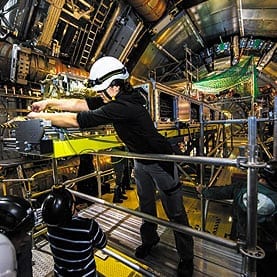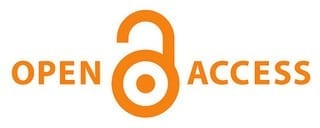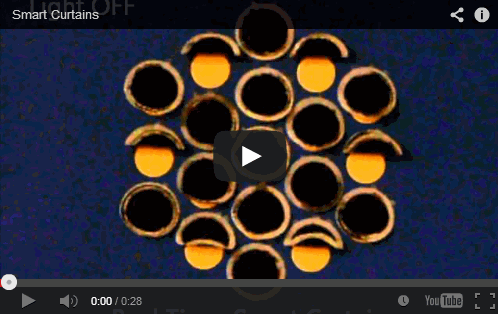
A major journal is balking at the plan, preventing over 3,000 high-energy physics papers from becoming open-access and sparking a minor stand-off with CERN
January sees the start of what has been billed as the largest-scale open-access initiative ever built: an international effort to switch the entire field of particle physics to open-access publishing.
But the initiative, organized by CERN, Europe’s high-energy physics laboratory near Geneva in Switzerland, has not yet fulfilled its dream — it currently covers only a little more than half of published particle-physics papers.
The scheme’s scope was slashed in the summer when the field’s largest journal, Physical Review D, pulled out, although its publisher, the American Physical Society (APS), did agree to publish papers on experiments at CERN’s Large Hadron Collider on an open-access basis without charging author fees.
And as the starting gun sounded, a number of US libraries, including those of Stanford University in California and Yale University in New Haven, Connecticut, declined to pay into the system. Robert Schwarzwalder, associate university librarian for Stanford’s science and engineering libraries, wants to see open-access research but is not sure that CERN’s initiative is needed, given that versions of almost all high-energy physics articles already appear online for free on the preprint server arXiv and the repository INSPIRE-HEP. Yale did not return Nature’s calls.
In the global scheme, called the Sponsoring Consortium for Open Access Publishing in Particle Physics (SCOAP3), libraries either pay reduced subscription fees for participating journals, or stop paying them altogether. The cash saved goes into a central SCOAP3 fund, used to pay publishers up front to publish open-access articles.
Instead of hiding articles behind paywalls, publishers will make them immediately available on their own websites, with generous rights for reuse. Authors will retain the copyright. Libraries will not necessarily save money, because the average fee for publishing a paper — €1,150 (US$1,570) — has been set roughly to match publishers’ lost subscription revenues. But in three years’ time, contracts may be renegotiated, so open-access fees might go down.
The Latest on: Open-access
[google_news title=”” keyword=”Open-access” num_posts=”10″ blurb_length=”0″ show_thumb=”left”]
via Google News
The Latest on: Open-access
- Colorado's ski season isn't over yet. Here's what's open in May.on May 2, 2024 at 5:34 pm
Copper Mountain has extended its season with closing set for May 12. Lift access is now based out of East and Center Villages only according to Colorado Ski Country USA, the state's non-for-profit ...
- New health center to open inside Grand Rapids school next yearon May 2, 2024 at 2:50 pm
The new health center at Harrison Park Academy will serve Grand Rapids Public Schools students and anyone between the ages of 3 and 21.
- Where to watch the Madrid Open: Live stream the 2024 tennis tournamenton May 2, 2024 at 2:19 pm
The tournament kicked off last week and will run until May 5. We've put together everything you need to know about the tournament, including where to watch the Madrid Open live streams.The women's ...
- American Council of Learned Societies Announces 2024 ACLS Open Access Book Prize and Arcadia Open Access Publishing Award Winnerson May 2, 2024 at 8:01 am
Inaugural $50,000 Prize Awards and Expands Open Access Book Publishing in the Humanities NEW YORK, May 2, 2024 /PRNewswire/ -- The American Council of Learned Societies (ACLS) is pleased to announce ...
- Abiotic Factor - Official Early Access Launch Traileron May 2, 2024 at 8:01 am
Abiotic Factor is available now in Steam Early Access. Watch the Early Access launch trailer for Abiotic Factor to see the terrifying creatures you'll encounter, gameplay, and more from this ...
- Automation Game Foundry Manufactures Its Early Access Releaseon May 1, 2024 at 5:00 pm
Foundry is available again with its Early Access release. The basic setup is pretty much exactly what anyone who's played a factory game would expect. You start off in an open world with resources ...
- Prime Coalition and Rho Impact Unveil New Open-Access Tool to Assess Impact Potential of Climate Technologieson May 1, 2024 at 4:11 am
Prime Coalition and Rho Impact unveiled the new CRANE tool during a San Francisco Climate Week (SFCW) panel discussion last week. For climate-conscious impact investors who are interested in more than ...
- United Arab Emirates University and Taylor & Francis announce open access partnershipon April 30, 2024 at 5:00 pm
United Arab Emirates University (UAEU) and Taylor & Francis have announced a new three-year transformative agreement. Researchers at UAEU can now choose open access (OA) in over 2,500 journals, ...
- Applications now open for fund to increase access to Oregon’s legal psilocybin programon April 30, 2024 at 11:24 am
The Psilocybin Access Fund opened applications for grants to support legal psychedelic mushroom experiences in Oregon.
- Shut Out: A guide to help the owner — the public — have access to open recordson April 30, 2024 at 5:00 am
Part Two of a report from a Poynter ethics symposium explores increasing public records denials and how journalists can push back ...
via Bing News










